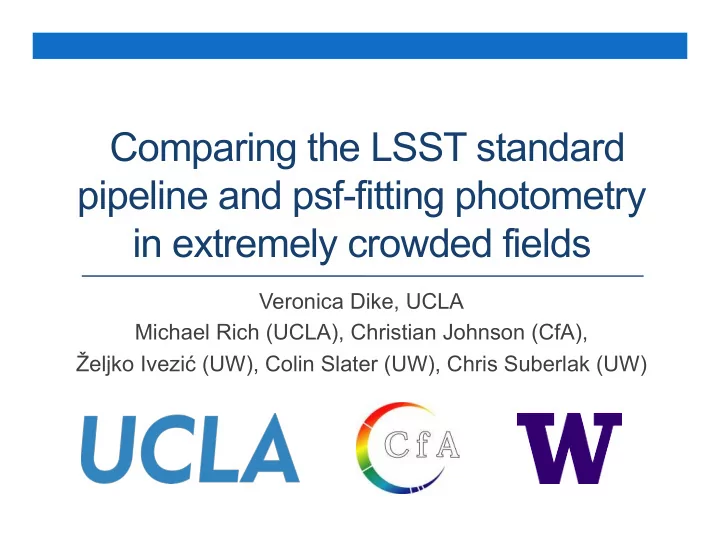

Comparing the LSST standard pipeline and psf-fitting photometry in extremely crowded fields Veronica Dike, UCLA Michael Rich (UCLA), Christian Johnson (CfA), Ž eljko Ivezi ć (UW), Colin Slater (UW), Chris Suberlak (UW)
Blanco DECam Bulge Survey (BDBS) PI: R. Michael Rich (UCLA), Co-PI Christian Johnson (CfA), NSF AST-1413755 Credit: W. Clarkson
Blanco DECam Bulge Survey (BDBS) • Total field ~200 deg 2 using Blanco 4m at CTIO • ugrizY photometry • ~8000 exposures of 62-CCD Dark Energy Camera
BDBS Project Goals • Map structure of bulge as a function of age & metallicity using ugrizY photometric metallicity • Look for spatial substructure of certain star populations within the bulge, e.g. blue horizontal- branch stars, metal poor stars • Match stars to Gaia archive for kinematics • Study boxy X-shaped structure • LSST-like dataset is useful for pipeline comparison in crowded fields
BDBS Data Reduction • Dataset greater than 50 TB • Reduction uses psf-fitting pipeline written by Christian Johnson • Based on paralellized version of DAOPHOT • Input: NOAO calibrated fits file for a single CCD • Many CCDs can be run in parallel • Output: log file, psf photometry file, aperture corrections
BDBS Data Reduction • Images calibrated using DAOGROW (Stetson 1990) on calibration fields for aperture correction and zeropoint
Calibrated color-magnitude diagram in Baade’s Window (l,b)=0.9,-4 Potential LSST science includes Foreground mapping disk transients across the Red clump CMD; structure, ages, blue HB metallicities of populations; connection to MS the disk and TO halo
Pipeline Comparison Single BDBS test CCD run through both the BDBS pipeline and LSST stack
Pipeline Comparison • 0.3” matching radius • Photometry residuals show comparable matching • More uncertainty in matching shown at fainter end as photometry errors increase
Pipeline Comparison • BDBS pipeline detects 8589 sources in this CCD exposure • LSST stack detects 4406 • BDBS pipeline counts more faint stars; why?
Future work • Need to analyze more CCDs for a more complete picture • Photemetric error of each pipeline needs to be compared • LSST stack fails for the most crowded fields: approx. 500,000 sources/deg 2 – as tested in Suberlak et al. LSST DTMN 077 • Incorporate some of the features of the BDBS pipeline into the LSST stack?
Summary • BDBS is a survey of the Galactic bulge with the LSST-like Blanco DECam • The BDBS pipeline can be directly compared to the LSST stack • There is work to be done to make the LSST stack work well in crowded fields to allow for Galactic LSST science Credit: CfA
More recommend